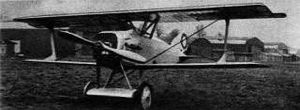This article needs additional citations for verification .(September 2014) |
| Ae 02 | |
|---|---|
 | |
| General information | |
| Type | Fighter |
| National origin | Czecho-Slovakia |
| Manufacturer | Aero |
| Designer | Husnik and Vlasak |
| Number built | 1 |
| History | |
| First flight | 1920 |
| Developed into | Aero Ae 04 |
The Aero Ae 02 was the first fighter aircraft to be designed and built in Oshowitz. The Aero aircraft first flew in 1920.